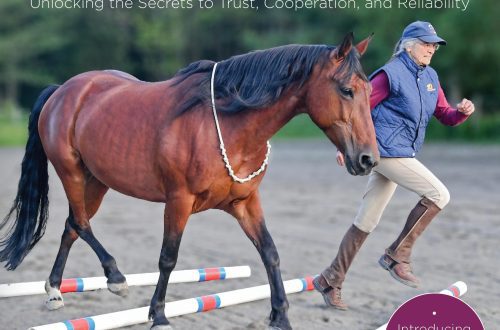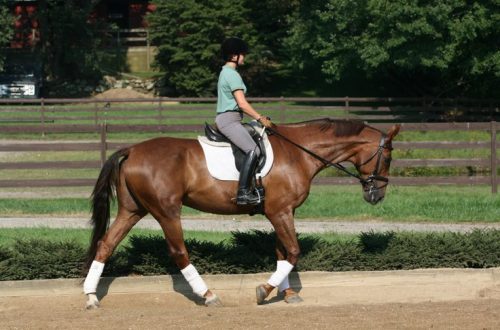
How to evaluate the behavior of horses in a herd?
How to evaluate the behavior of horses in a herd?
The surest sign of the prevailing good atmosphere in the herd is horses grazing peacefully side by side. But not always everything goes smoothly, because the composition of the “stable” herds changes too often – some horses leave, changing their place of residence, others appear. Each time the relations in the herd have to change in one way or another.
What does the behavior and mood of our horses in the pasture tell us, and what can we do to harmonize the atmosphere inside the herd?
One day, my daughter and I watched two horses walk along the fence of their levada. A four-year-old gelding is in front, and his mother is in the back.
– Look! He finally became the leader! Bring your mom! my daughter said happily
But what did I see? Only that mother is a horse, lowering her head to the tail of her adult son, she pushed him forward, acting like a dominant horse.
The dynamics of the herd is an amazing thing! Even in a small home group, walking in a modest size levada, horses can behave in a way that their behavior will be misinterpreted by people. For example, if horse A has already finished drinking, then why does he not allow horse B to approach the water? And how is it that one red horse treats another red horse well, but drives the gray one away?
It is great that more and more horse owners are recognizing the importance of giving horses the freedom to socialize outside the stable. But this means that there is an increasing need to better recognize and understand the dynamics of the herd. While most horses build their relationships without human influence, it’s still important for us to know what’s going on. Understanding the social interactions of our horses will allow us to take better care of them, understand their actions better, and communicate with them more effectively.
Social behavior: good and bad
Horses use a wide range of subtle methods of communication. According to Sue M. McDonnell, a certified animal behaviorist and founder of the Equine Behavior Program at the University of Pennsylvania School of Veterinary Medicine, even a slight turn of the ear or movement of the tail is a message from the horse to the herd. “This is especially true when the roles in the herd are clearly defined, she says. “The more division and clarity in the order of dominance, the more subtle signals are sent by the horses and the more peaceful the mood throughout the herd.”
Horses can communicate information to each other through sounds such as neighing, snorting, squealing, as well as stomping and stomping. Smells are also important – horses often sniff each other’s manure, and also sniff the breath.
So how do people decipher if their horses get along well with each other? Researchers believe that the strongest positive social signs that horses exhibit are probably quite graphic. “Standing next to each other probably tops this list,” says Lina Peerstrup Arendt, a researcher in the department of animal husbandry at Aarhus University in Denmark. scratch each other’s withers, backs or necks.
Negative signs are manifested as follows: squeals, threats of bites, threats of blows, laid back ears and bulging eyes. In extreme cases, threats can actually lead to real hits and bites.
“But people need to understand that these negative behaviors don’t necessarily mean the horses don’t get along,” Arendt says. “This communication serves to create and maintain social hierarchies, which is completely normal among horses in a herd.”
If horses don’t become particularly violent and dangerous towards each other, which we’ll talk about later, it’s best for humans to let them sort out their hierarchy and create order on their own, according to their natural instincts.
Most often, what we usually see when looking at the herd is ordinary communication. Especially when you can clearly distinguish between truly confident, dominant animals and truly submissive, respectful, inferior members of the herd. In such situations, there is rarely overt aggression requiring intervention.
Dominance, leadership and hierarchy
This part of equestrian nature originates from the time of wild herd existence. Domestic horses, like their wild ancestors, create a social hierarchy. This gradation works to protect the herd, create family groups, and prioritize access to resources (food, water, and shelter).
“We like to think that our horses are good, generous and good-natured, but the fact is that they really are what the herd makes them,” says Elke Hartmann, an environmental and health officer at the Swedish University of Agricultural Sciences. in Uppsala.
The horses determine the order in which the members of the herd eat or go to cover. “When we talk about social order in a group of domestic horses, it all comes down to resources,” says Hartmann.
In fact, some horses can be so dominant that they “guard” food, water, and shelter even when they don’t need them, and other horses can’t access these resources. “You will see these horses stand in the stable aisle or keep their heads above the common water bowl, preventing other horses from approaching,” says Hartmann. However, in most cases, “If a horse at the top of the herd is not hungry, it will certainly let the other horses eat,” she says.
Horse hierarchies are often quite complex. There is no clear line of hierarchical order from the top horse to the bottom horse. “Hierarchy is never linear,” says Arendt. “Some horses will be at equal levels, and sometimes you can have triangles where one horse dominates another, this other horse in turn dominates a third, which dominates the first.”
However, two things are always present: there is always a leader and there is always the main dominant horse in the herd. But the interesting thing is that it is not always the same horse. In fact, Hartmann adds, it is not necessary that there is only one horse in the herd that is the consistent leader. “In the course of the research, it was suggested that the decision to follow the horse that initiated the movement somewhere is influenced by various factors, including including the factor of the social status of a particular horse,” she says.
Getting the full picture
“Scientists are exploring herd hierarchy through extensive field observations—up to 15 hours a day,” says Arendt. Fortunately, she and her fellow researchers have developed a faster method: the “limited resource” test.
By placing three feeders in a pasture, they studied the interaction between 25 geldings, which took only 80 minutes over four days. “The results showed that a limited resource test with less time can provide the same information about the hierarchy based on aggressive collisions as if we used a long-term field observation method,” she says.
However, for those who are not connected with science, for simple equestrians, it is possible to determine the dynamics of the herd with the help of regular observations over a certain period of time. “By periodically checking horses once or twice a day, you won’t get an accurate picture,” says Hartmann. “You will need to sit and watch often and for long periods of time. In addition, relationships can develop and change over weeks, months, and years. A horse is not born dominant and will not be dominant all its life.”
Creation of groups and formation of friendships
“Within a herd, horses tend to break up into what researchers call ‘subgroups’ — smaller groups that tend to stay together but don’t stray far from the main herd,” says Hartmann. “It is in these subgroups that horses really have their closest ‘friends’, if we can call them that.”
“When we talk about “friends among horses,” we humanize them a little,” says Arendt. “We know that they form close relationships with horses in their subgroups, something similar to what we see in human friendships.”
Why does a horse like one horse but not another? Hartmann and Arendt admit they don’t really know. Sometimes it seems that the color may have something to do with this: “Horses of the same color often “friends,” says Hartmann. “She can remind them of their mothers or their friends from when they were still foals.”
Arendt has heard that white or light gray horses are often disliked by other horses. “But so far there is no scientific evidence for this,” she clarifies.
“Past experiences will also influence the choice of horses, causing them to prefer companion horses that are similar to others they have loved in the past,” adds Hartmann. — Personality and temperament probably also play an important role. Everything, like people, is very individual.
The horse that doesn’t want to join the herd
Sometimes you get a horse that just won’t join the herd. Maybe she is at a very low level in the hierarchy and cannot find a friend, isolated from the group. Or vice versa, she is so aggressive that she does not allow others to approach her, and even becomes a danger to herself and other horses. Also, in rare cases, it may be a horse that does not have social skills (most often, a horse that grew up in isolation) – he simply cannot get along with other horses.
“There may come a time when you have to actually remove the horse from the herd,” says Dr. Elke Hartmann. “Take her out of there and try herding with another herd to see if she has a chance.”
Sue McDonnell, a certified animal behaviorist and founder of the Equine Behavior Program at the University of Pennsylvania School of Veterinary Medicine, adds that a particularly aggressive horse may do better in a herd with clearly more dominant or clearly less dominant horses. But, if she, not knowing the boundaries of behavior, gets into a herd with more dominant horses, she risks getting injured.
“Ideally, if there are an even number of horses in the herd, then the chance of a horse being left alone decreases,” says Hartmann.
herd management
Unfortunately, according to the researchers, getting horses to treat each other well is impossible. They are either friendly or not.
But what you can do is give them the opportunity to keep space between them. “They really need a large enough area to be able to get away from each other if necessary,” says Arendt.
How big? Well, again, science hasn’t gotten that far in herd dynamics. Use common sense when letting two or more horses out into the field. Make sure that each horse has a place to show submissive behavior, essentially escaping the chase. Also keep a close eye on the herd in the early days to see if any horse is cornered and can avoid threats from other horses.
A small herd
“Two horses still qualify as a herd, but their relationship can be somewhat unnatural because the horses have no choice in their camaraderie,” says Hartmann. – Horses are forced to be the sparter that people have chosen, and they need to come to terms with this in order to satisfy their and his social needs. The fact that a horse has a companion is good for its well-being. But that means you need to keep a close eye on them to make sure they tolerate each other. You can’t expect them to be necessarily friends. You may even need to separate such horses with partitions so that they cannot harm each other.
When to Intervene
Given enough space to run, most horses will develop their pecking order on their own. Even if you have only stallions (strictly no mares!), they can create a safe and harmonious hierarchy if they have a large living space and people do not interfere in their socialization processes. For example, Swiss researcher Sabrina Brifer-Freymond, PhD, had the experience of observing eight stallions living peacefully side by side for two years.
But we always remain responsible for the welfare of our animals, giving us the right to intervene if things go wrong.
“If you see one horse losing weight and not getting enough food because it eats slowly and is submissive to an aggressive horse that takes its food, then you need to fix that problem,” says Arendt. “Tie up horses at meal times or separate a slow eater until he’s done.”
“Be careful and carefully observe the interaction before intervening,” adds Hartmann. You must follow developments. If you see that the level of aggression is unnecessarily high, and if the endangered horse does not leave to protect himself, then you may need to intervene and possibly change the composition of the group.
The best thing you can do to ensure good socialization among horses is to start with their good social education, Arendt and Hartmann say. – Keep horses in groups from their youngest age, ideally from birth, but especially in the first four years of life. Place them with horses of all ages, sizes, breeds, genders and colors in those years. We now know that the old tradition of keeping only young horses together—weaners, one-year-olds and two-year-olds separately, and three-year-olds separately is not the best solution for their social education.
Horses are social animals and seek companionship with other horses and they communicate to establish firm social norms. By recognizing the social order of our herds and managing horses based on their choices and needs, we can help ensure their well-being.
Translation by Valeria Smirnova based on site materials http://www.horsechannel.com.





